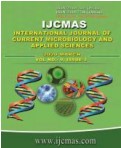


 National Academy of Agricultural Sciences (NAAS)
National Academy of Agricultural Sciences (NAAS)

|
PRINT ISSN : 2319-7692
Online ISSN : 2319-7706 Issues : 12 per year Publisher : Excellent Publishers Email : editorijcmas@gmail.com / submit@ijcmas.com Editor-in-chief: Dr.M.Prakash Index Copernicus ICV 2018: 95.39 NAAS RATING 2020: 5.38 |
The cashew (Anacardium occidentate L.) belongs to the family Anacardiaceae, it has been described as a small to medium sized tree found in Northern part of South America which was originated from Brazil. India is the largest (90%) exporter and producer of cashew kernels in the world. Eventhough, cashew is generally grown as rainfed crop with little or no manure and fertilizer application were followed by the most the farmers but cashew responds well in fertilizer application. Cultivation without manures and fertilizer application resulted in expression of deficiency symptoms for both major and micronutrients especially N, K, Fe, Zn and B which is reduced the yield. Based on this background, the present study on “Effect of soil application of micronutrients in cashew” was undertaken at Horticultural College and Research Institute, Periyakulam and to study the soil application of micronutrients, recommended dose of fertilizers along with soil application of different levels of micronutrients at new flush stage (June – July), just before flowering (October - November) and nut development stage (January – February) were applied. The experiment was laid out with Randomized Block Design (RBD) with seven treatments and replicated thrice. The result revealed that the soil application of recommended dose of fertilizers along with soil application of micronutrients (T3) (NPK - 280:160:240 g NPK/tree + Ferrous sulphate - 200g /plant) registered the highest values in the traits like nut weight (59.11 g), yield per tree (11.14 kg), estimated yield per ha (2.25 t/ha) and B:C ratio (2.41) whereas the T1 (control) recorded the lowest values in all the traits.
 |
 |
 |
 |
 |